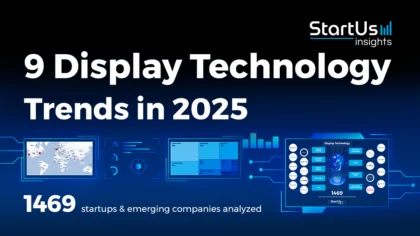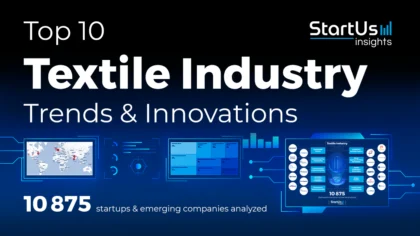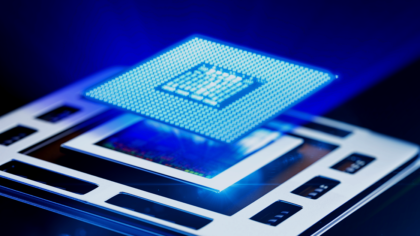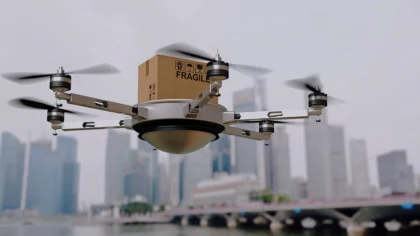Accelerate Productivity in 2025
Reignite Growth Despite the Global Slowdown
The rapid growth in online gaming and entertainment allows audiences to spend more time on televisions, tablets, and smartphones, leading to a demand for superior visual experiences. This demand advances innovation in display technologies. OLED and micro LED technologies are replacing LCDs to enhance display performance. Startups develop technologies like quantum dot (QD) displays, including flexible, immersive, projection, and laser-based displays. Read on to discover their impact on your business.
This article was last updated in July 2024.
Innovation Map outlines the Top 9 Display Technology Trends & 18 Promising Startups
For this in-depth research on the Top Display Trends & Startups, we analyzed a sample of 1469 global startups & scaleups. This data-driven research provides innovation intelligence that helps you improve strategic decision-making by giving you an overview of emerging technologies in the display industry. In the Display Technology Innovation Map, you get a comprehensive overview of the innovation trends & startups that impact your company.
Top 9 Display Technology Trends
- Flexible Displays
- Immersive Displays
- Digital Signage
- Micro LEDs
- LCDs
- Projection Technologies
- OLEDs
- Quantum Dots
- Laser-based Display Technology

Want to explore all Display Technology innovations & trends?
These insights are derived by working with our Big Data & Artificial Intelligence-powered StartUs Insights Discovery Platform, covering 4.7M+ startups & scaleups globally. As the world’s largest resource for data on emerging companies, the SaaS platform enables you to identify relevant technologies and industry trends quickly & exhaustively.
Tree Map reveals the Impact of the Top 9 Display Technology Trends in 2025
Based on the Display Technology Innovation Map, the TreeMap below illustrates the impact of the Top 9 Display Technology Trends in 2025. Currently, the largest consumer demand focuses on lighter and thinner flexible displays for foldable phones. The diverse use of immersive displays and projection technologies in the advertising, gaming, and entertainment industries drives innovations in that direction as well.
The marketing sector is utilizing digital signage to reach more customers. At the same time, technologies like Micro LED, LCD, OLED, QD, and laser-based display technologies see a lot of activity. With them, manufacturers are able to develop high contrast, low reflection, and wider viewing angle displays.
Global Startup Heat Map covers 1469 Display Technology Startups & Scaleups
The Global Startup Heat Map below highlights the global distribution of the 1469 exemplary startups & scaleups that we analyzed for this research. Created through the StartUs Insights Discovery Platform, the Heat Map reveals high startup activity in the UK and the US. Below, you get to meet 18 out of these 1469 promising startups & scaleups as well as the solutions they develop. These display technology startups are hand-picked based on criteria such as founding year, location, funding raised, & more. Depending on your specific needs, your top picks might look entirely different.
Top 9 Display Technology Innovation Trends in 2025
1. Flexible Displays
The capability to enable thin, lightweight, and unique form factors makes flexible displays an exciting innovation. They also support low-cost roll-to-roll manufacturing, which is why flexible displays find use in wearables, automotive head-up displays (HUDs), and smartphones. Some of the technologies in building a rollable display include electronic ink, gyricon, organic LCD (OLCD), and OLED.
Additionally, these displays are less prone to breakage, unlike rigid glass substrate-based displays. Major uses of flexible displays include electronic paper for dynamic posters and signages as well as foldable phones.
SuperUs Systems offers Electronic Paper Devices
SuperUs Systems is an Indian startup that provides electronic paper devices. These e-ink devices use tiny capsules containing microscopic particles of multiple colors and electrical charges. The electrodes make the e-paper surface reflect a certain color. Since they consume power only when the content on display changes, they are energy efficient. The retail and advertising industry utilizes it for electronic shelf labels, seat tag displays, and more.
BeTerrific Tech manufactures Modular LED Panels
US-based startup BeTerrific Tech designs modular LED panels. The startup’s product, Agility Quadricep, follows a flexible cabinet design that allows panels to fit in any combination of flat or curved surfaces without gaps. They are ideal for displays on ceilings, posters, corners, etc. Marketing companies leverage these weather-resistant and durable panels to advertise their products.
2. Immersive Displays
The applications of immersive display technologies vary from industry to industry. For example, virtual reality (VR) interactive environments provide enhanced perception to increase engagement and learning in virtual meeting rooms. Display technology startups and scaleups also develop tiny screens and lenses that simulate large screens. This encompasses most of a user’s field of view (FOV), thereby offering panoramic virtual screens.
At the same time, such displays provide interactive augmented realities (AR) for viewers through head-mounted displays (HMDs). This enables augmented shopping and improves decision-making through real-time situational awareness. Immersive displays thus enable convenient, personalized experiences.
Swave Photonics designs Holographic Microchips
Swave Photonics is a Belgian startup that manufactures holographic microchips. They enable holographic extended reality (HXR) gigapixels using a diffractive photonics technology. As a result, it powers ultra-high resolution, lifelike 3D displays. Businesses use this technology to engage in immersive video conferences while working remotely.
BRELYON provides Virtual Display Monitors
US-based startup BRELYON offers virtual display monitors. They provide a panoramic virtual image with true optical depths across the viewer’s FOV. Thus, it relaxes the ciliary muscles of the eye and reduces vergence stress, enabling comfortable extended use. With BRELYON’s virtual monitors, companies are able to replace their multi-monitor setups and improve productivity.
3. Digital Signage
Digital signage uses display technologies such as LCD, LED, projection, and e-paper. The rapid drop in the price of LCD screens also increases their integration into digital signage. Startups and scaleups develop digital signages with interactive displays with touchscreens, QR codes, or Bluetooth. They increase user engagement by allowing customers to participate in various activities such as polls, games, etc.
Additionally, companies use content management systems (CMS) and digital media distribution systems to run and modify these digital signage displays. They are especially useful to provide public information and share product information for brands.
VideowindoW develops Transparent Solar Screens
VideowindoW is a Dutch startup that makes transparent solar screens. The startup utilizes multiple modules consisting of light sensors to make these screens. It also uses advanced algorithms to incorporate real-time data from exterior luminescence and temperature for glare control and thermal insulation. Marketing companies and designers use these screens as digital signages or media display systems in establishments such as airports.
PanoScape Holdings offers an Interactive Digital Canvas
US-based startup PanoScape Holdings provides an interactive digital canvas. It couples a cloud-based CMS with real-time analytics. The canvas switches to an interactive mode when the viewers engage with the screen. Restaurants and malls leverage this technology to provide ultra-high-resolution content to customers.
4. Micro LEDs
Micro LED displays consist of numerous microscopic LEDs that self-illuminate per display pixel. Unlike OLED displays, micro LEDs use inorganic materials. As a result, they feature ultra-low black levels with higher peak brightness. Moreover, the contrast ratio is much higher than in OLEDs. Micro LED displays are also modular by design as they make use of multiple smaller displays to form a large screen, increasing customizability. The main advantages of micro LED displays are longer lifespan and lower power consumption, improving sustainability.
Porotech makes Full Color Micro LEDs
Porotech is a UK-based startup that creates full-colored micro LEDs. The startup’s technology, DynamicPixelTuning (DPT), allows manufacturers to replace red green blue (RGB) sub-pixels with a single pixel to create any color in the visible spectrum. As a result, semiconductor companies leverage this technology to better engineer porous GaN materials for displays.
LC SQUARE provides Laser-based Micro LEDs
South Korean startup LC SQUARE manufactures laser-based micro LEDs. The startup utilizes laser-induced forward transfer technology (LIFT) for mass transfer within these micro LEDs. As a result, it quickly detaches micro LEDs from sapphire wafers and arranges them on top of interposers. This eliminates intermediary processes and enables manufacturers to easily move micro LEDs on driver circuits.
5. LCDs
LCDs use light modulating nature of liquid crystals to display images. Many electronic devices such as televisions, computer monitors, digital cameras, and watches already utilize this display technology. In comparison with heavy CRT displays, LCDs offer compact and thin structures while requiring lower power. Due to the high costs of OLEDs and micro LEDs, companies are exploring low-cost applications of LCD in wearables such as fitness bands.
LCD’s competitiveness in the market also exists because of its use in cost-efficient touchscreen devices for industrial applications. Further, companies are enhancing LCD picture quality using quantum dots. However, the production of environmentally hazardous e-waste due to LCDs will push companies to focus on solutions such as OLED in the future.
Seeing Display Technology creates Energy-Efficient LCDs
Seeing Display Technology is a Taiwanese startup that devises energy-efficient LCDs. The startup’s memory-type liquid crystal technology, MLC, controls and maintains the light transmission of liquid crystal films or glasses.
The startup does this by switching the input power on and off, thereby reducing power consumption. Display manufacturing companies leverage MLC to reduce carbon emissions.
Nanolumi offers Color-enhanced LCD Films.
Singaporean startup Nanolumi produces color-enhanced LCDs. The startup’s product, Chameleon G, consists of perovskite nanocrystal-based film and cadmium-free narrow green emitter. They together offer a combination of energy-efficient LCDs with better color performance and brightness in comparison to OLEDs.
Since they replace traditional LCDs using a simple drop-in solution, it is useful for companies developing low-cost, high-performance displays.
6. Projection Technologies
Projection technologies are emerging as one of the major real-world and information tools in the advertising and architectural industries. They were previously limited to standard projectors that illuminated a screen or wall under low light. However, recent advances expand the scope of projection technologies with 3D image projection, including holograms and window signage applications.
For example, some solar-absorbing window glasses turn into display panels during the daytime while others convert into transparent displays. In some cases, projection technologies overlap with immersive technologies as is seen in the case of AR and holographic projections. Marketing and product development companies rely on such technologies for offering close to real-life objects and portability.
ARCYTEC develops Camera Sensors & Depth Sensing
Israeli startup ARCYTEC develops technologies with camera sensors and depth sensing for consumer and industrial markets. The startup’s technology applies to camera modules and laser-based projectors, offering flexibility, cost reduction, and performance improvement. ARCYTEC’s customized modules include the Dot DOE pattern projector, which features up to 60K dots and a pseudo-random pattern for advanced performance. Its light detection & ranging (lidar) systems design leverages micro-electro-mechanical systems (MEMS) controllers and optical design expertise to create high-performing systems. Complementary metal-oxide-semiconductor (CMOS) camera modules cover a spectrum from near-infrared (NIR) to visible, suitable for applications ranging from drones to AR/VR/MR.
Visual Feeder develops a Sensor-enabled Projection Display
US-based startup Visual Feeder creates a sensor-enabled projection display. The startup equips window-scape locations with real-time analytics sensors. They track live engagement by analyzing foot traffic, actual impressions, and dwell time. As a result, ad and marketing agencies leverage this solution for testing campaign concepts and metrics.
7. OLEDs
OLEDs consist of flexible sheets containing organic electroluminescent material that emit flat light. Thus, they do not require a backlight, as well as are thinner and more efficient than LCDs. Moreover, OLEDs provide improved image quality by enhancing contrast and brightness. They also allow fuller viewing angles, a wider color range, and much faster refresh rates.
As a result, it is one of the most promising alternative display technologies for plasma and LCD displays. Smartphone and wearable manufacturers use OLED screens, including flexible OLEDs, in their products.
Noctiluca produces OLED Emitters
Polish startup Noctiluca creates OLED emitters. They use thermally activated delayed fluorescence (TADF) technology to emit light upon electricity application. Along with the rest of the organic materials, these emitters form sub-pixels, the basic building block of OLED displays.
Display manufacturers use this innovation to obtain efficient blue emitters without the use of heavy metals that cause burn-in.
Mattrix Technologies offers Recycled OLEDs
Mattrix Technologies is a US-based startup that provides recycled OLEDs. The startups leverage recycled LCD-TFT array lines for active matrix OLED and AMOLED manufacturing. Further, the startup’s organic light emitting transistor (OLET) technology combines current control with light emission.
This enables high brightness and contrast, which is why smartphone and automotive manufacturers use it for always-on, wrap-around, and rollable displays.
8. Quantum Dots
Quantum dot or quantum dot LED(QLED) displays utilize tiny phosphorescent crystals that react to light and electricity. Unlike conventional LEDs that use pure white backlights, these tiny nanoparticles are struck by blue light. As a result, they emit red or green light which enables highly saturated and accurate colors than an average LED. The benefits of QDs include better energy efficiency and longer lifespan. They also feature low burn-in and allow a greater range of panel sizes.
Currently, the most common displays that use this technology are televisions. However, startups and scaleups are leveraging quantum dots to enhance gaming experiences through high-performance monitors.
QustomDot makes Display Nanoparticles
Belgian startup QustomDot develops display nanoparticles. The startup’s nanoparticles or quantum dots comprise InP QDs for color conversion and InAs QDs for infrared (IR) sensing or imaging. This technology allows direct use of these QDs on LED chips, enabling novel applications like micro LEDs. The color-tuning ability of the startup’s QDs also makes it apt for immersive displays.
NanoPattern Technologies commercializes Quantum Dot Inks
NanoPattern Technologies is a US-based startup that makes quantum dot inks. The startup’s patented ink formulation supports high-resolution QD downconverter layer patterning. It replaces high-performance monochrome displays to accommodate more colors and enables low-cost manufacturing of next-gen displays.
9. Laser-based Display Technology
Laser-based display systems find applications as a projection technology and as a video technology. In both these forms, displays use two or more modulated optical lasers as the light source. As a result, laser-based displays obtain high-fidelity images with high definition, a large color gamut, and better viewing comfort. This means that the images are always laser sharp even when projecting onto uneven or curved surfaces.
Compact laser systems, such as edge-emitting diodes, vertical-cavity surface-emitting lasers, and optically pumped semiconductor lasers, are suitable candidates for laser-based displays. Pico projectors and laser televisions also utilize these laser systems. Many startups and scaleups are developing solutions to improve image quality by targeting issues such as laser speckle.
BRYTN offers a Laser Heads-up Display (HUD) System
BRYTN is a South Korean startup that develops a laser HUD system. It is a laser optical engine that functions as a picture-generating unit (PGU). The system adjusts the focal length of the virtual image with a brighter, clearer, larger-sized virtual image.
The company’s HUD system allows automotive manufacturers to integrate 3D AR HUD without massive development costs, improving driver safety and convenience.
OQmented makes AR Smart Glasses
OQmented is a German startup that devises AR smart glasses. They use laser beam scanning with 2D micro-electromechanical systems (MEMS) mirrors. This setup ensures 3D depth sensing as well as high-performance brightness and contrast. Wearable companies leverage OQmented’s technology to obtain low-powered displays effective even in broad daylight without compromising eye safety.
Discover all Advanced Display Technologies & Trends
Consumer preferences see a shift from plasma and LCDs to OLEDs and micro LEDs for better picture quality and higher energy efficiency. The raised awareness against e-waste is also pushing companies to provide more environmentally friendly display technologies. Among others, quantum dots, high-performance sub-pixels, and energy-efficient display technologies will transform the sector as we know it today.
The Display Technology Trends & Startups outlined in this report only scratch the surface of trends that we identified during our data-driven innovation & startup scouting process. Identifying new opportunities & emerging technologies to implement into your business goes a long way in gaining a competitive advantage. Get in touch to easily & exhaustively scout startups, technologies & trends that matter to you!










